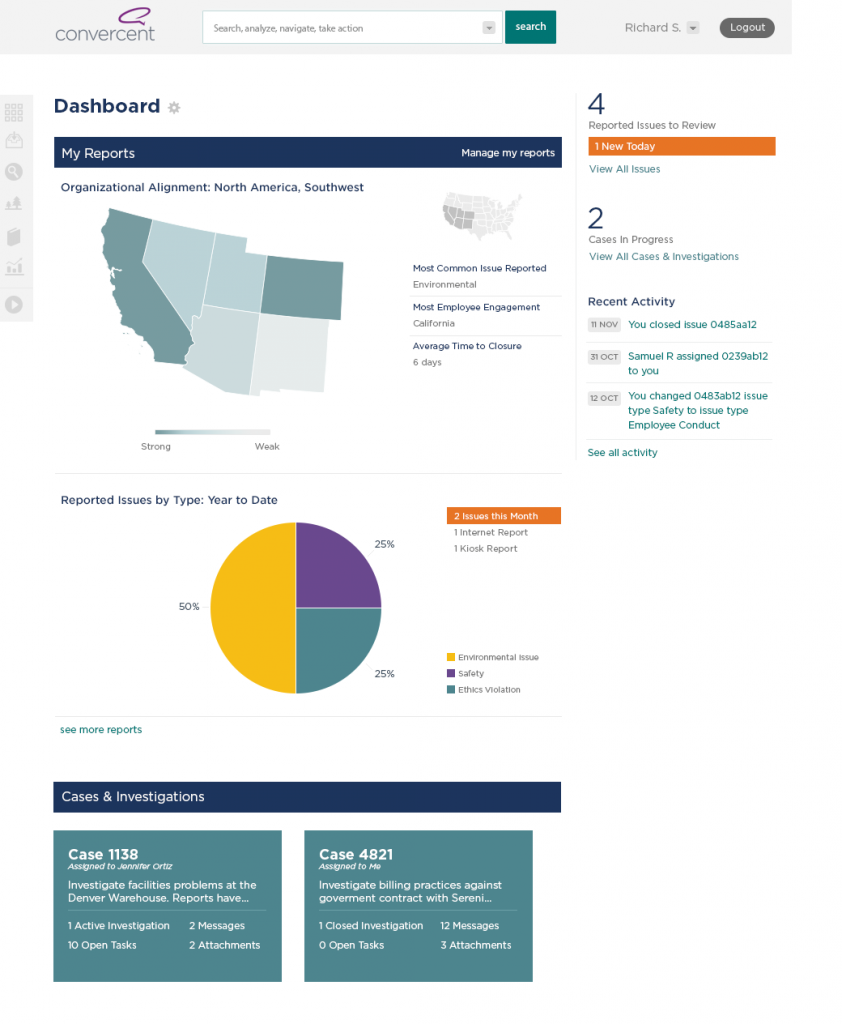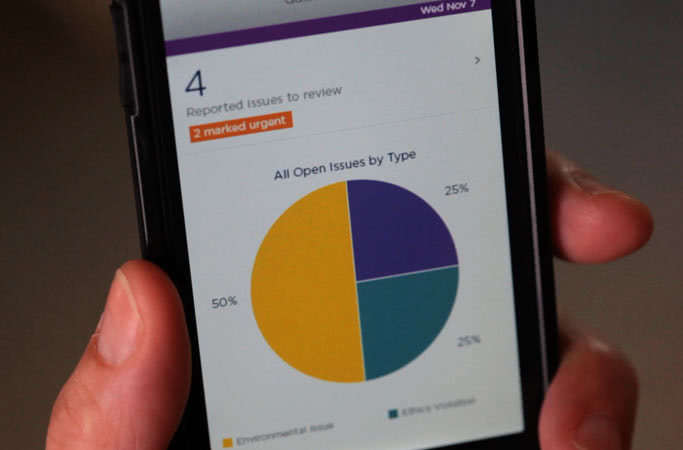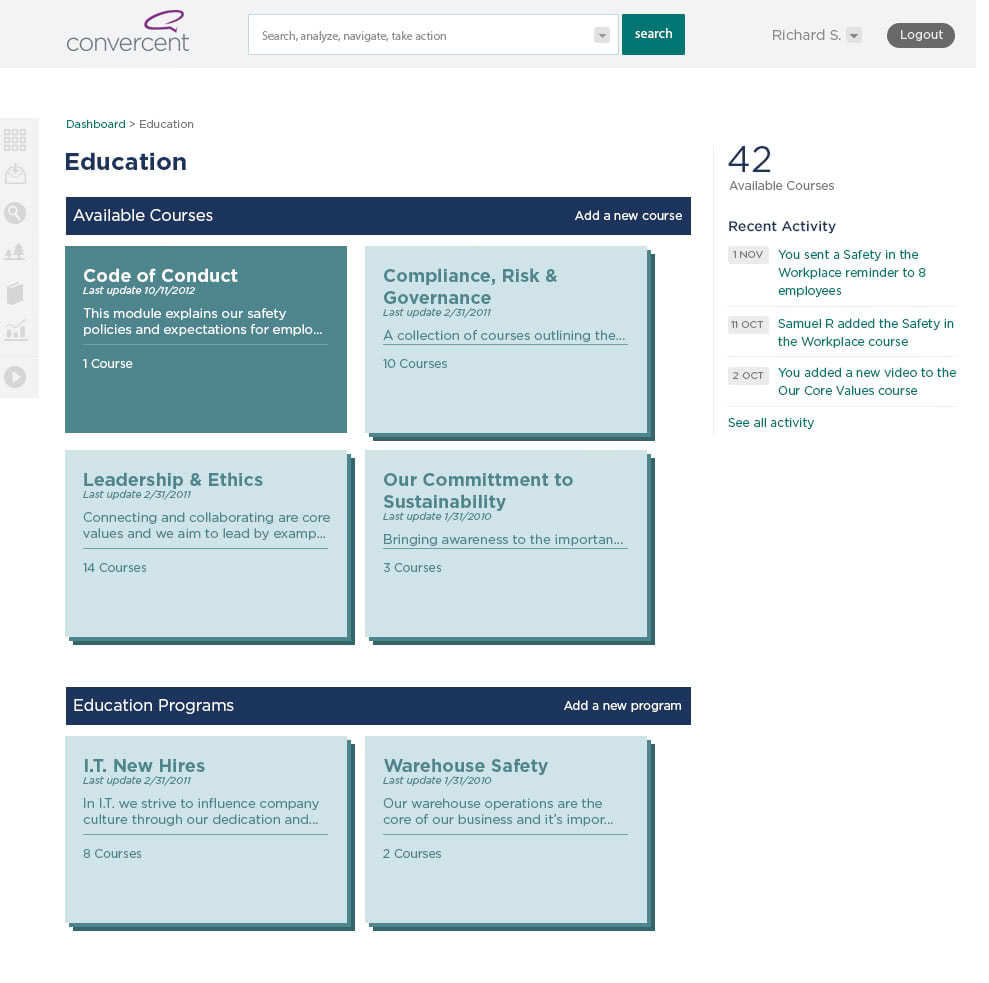Compliance Management
Behind the Software Q&A with Convercent's CEO and Chief Product Officer

In an industry inundated with dry segment names, Governance, Risk management and Compliance (GRC) may be one of the most prosaic of them all. However, the name belies the fact that many companies use this software as their means of training and tracking employees on their core values.
We sat down with Patrick Quinlan and Philip Winterburn, CEO and chief product officer of Convercent, respectively, about how their new brand of compliance software speaks to a world where more and more companies are placing their values and ethics at the forefront of what they do.
What was the inspiration behind Convercent?
Patrick Quinlan (P.Q.): The purpose of Convercent is to allow companies to manage their employees’ actions against ethics and values in the regulatory marketplace. If you look at the market today there are multiple different tools that exist, tools that, siloed the way they are, can potentially make it very difficult to achieve that outcome. There isn’t a single place a company can go that allows them the ability to manage not just compliance matters, but ethics and values as well. We provide the opportunity to manage all company policies, all education and baseline compliance measures.
That dovetails into my next questions: there are a lot of legacy solutions operating in the GC space right now from IBM and the like. How do you differ yourself from those established competitors?
P.Q.: It’s an insanely beautiful and easy-to-use software. We very much wanted to create a consumerized UX experience. It’s cloud based from both a launch and usability standpoint. It’s a product that operates off the current generation of technology, not four generations old like a lot of our competitors are. It also has native mobility being written alongside it, so it’s what you actually want out of technology, not just technology you have to use.
I’m going to ask you guys to extrapolate a bit: it’s obvious you’re doing something pretty original, so why has no one else capitalized on the ideas you’re bringing to this segment?
P.Q.: I think the reason is two-fold: one is that you have many companies today, ethical and values-driven companies, who are moving to the forefront. Let’s say Whole Foods as an example. What separates Whole Foods from all the other grocery stores in America is that they sell a promise of what their brand is and what it is that you’re buying from them. I think the advent of companies like Whole Foods has created a market opportunity built around companies who drive their belief structure above the simple regulatory structure. Those kinds of market opportunities are often best addressed by startup companies.
The second thing is that when you talk about those legacy systems, so much has been invested into that existing code that you generally don’t see the developers of those systems saying let’s step back, let’s create multilingual and mobile features like Phillip just described. That’s just not a natural reaction for incumbents to have.
Philip Winterburn (P.W.): I would say the only challenge they have is in addressing the way the industry is moving towards the consumerization of business software. Building from the ground up we’ve been able to bring in all those elements so that users will already be very familiar with the core concepts. In training you’re able to just jump in and start using the system. It’s fun to use and engaging versus the user interfaces of competitors who’ve been around for several years sitting on legacy-burdened, heavily menu-driven, training-intensive platforms.
Give an example of a target end user who’d be using Convercent within an enterprise.
P.Q.: If you look at large, publicly traded, Fortune Global 2000 companies they all have chief compliance officers. Those individuals often report directly to the CEO or CFO with dotted-line responsibility to the audit committee of a board of directors. These are positions that, as the regulatory environment has grown over the last ten years, have greater visibility within the organization. That individual is the core buyer and user of the product along with their staff, whether that would be fellow ethics officers, fellow investigators, etc.
You got started by acquiring Business Controls last year and using it as a base to build your current company off of. That’s a bit unusual compared to the typical startup narrative of everything being bootstrapped. What drove your decision to go this route?
P.Q.: That’s a great question, and I think there’s a little bit of irony in that you describe it as not being part of the usual startup narrative. The definition of an entrepreneur is to do things differently, and in that sense we are entrepreneurs.
What we saw in Business Controls was a company that had 16 years of experience becoming domain experts within a specific niche. The company today is much wider than that niche, but over those 16 years have developed 380 very passionate customers ranging from some of the largest companies in the United States down to small privately owned organizations, and what our expertise says between us four partners–Phillip, Barclay [Friesen], Chuck [Boyle] and I–is that we are accelerators, which means we understand how to take both a product in a marketplace and find the spot that you should move to as well as move there very fast with a team that already built in and a platform that already exists, allowing you to go from zero to a hundred miles an hour much faster.
P.W.: We deliberately came looking for this type of opportunity. This is what we do. We look for B2B companies who are in a fast market space, but trying to figure out how they climb up that space with their products, and who need accelerating, refining and relaunching.
P.Q.: And one thing we want to make clear though is that we’re not a turnaround team. The companies we look at are companies have always grown over time and now just need accelerating. We don’t come in and fix broken things, we take right opportunities and turn them into phenomenal opportunities.
Is it a challenge to take a nebulous concept like ethics or company values and quantifying it into a software system?
P.Q.: Let’s take values as an example. One of our customers has community service as one of their company values. That sort of value is something you generally see up on a wall somewhere in the office, so it’s hard to figure out how you actually get that driven throughout the organization. If you have a company value you can easily take policies and write them around those values, but if that value is community service and you don’t track it, if you don’t put information behind it, it’s hard to make it happen.
Imagine if you could take that value and create a set of company policies that say “we believe that to execute on this value we want every employee to put X amount of hours per quarter into community service, and we define community service as A, B and C, and here are the types of organizations that you can get involved with, and here’s how we implement this throughout the organization.” Then you can actually train on that and create training modules like great online videos or PowerPoints where new team members not just read the policy but then take tests to ensure they actually understand them, and, more importantly, take examples of those values and post them back into the system.
So if your value is community service you read the policies on it, you took the training class, you went to a Habitat for Humanity job site, you’re on the job site, you put a hard hat on, walk up to the door, take a picture of that door and then you post it back into the system. The very next day when a new employee is joining the organization and they look up the community service section under values, there’s a whole series of pictures behind it that shows living breathing examples of taking a nebulous concept and turning into a digital fact.
One criticism of compliance software is that a lot of them work on a negative reinforcement concept, making you read X, Y and Z manuals and tick off a checklist to penalize you if you didn’t do it. How do you attempt to avoid that?
P.Q.: I really appreciate that question. One of our six values as a company at Convercent is positivity. We believe that to be able to get up in the morning and be passionate and excited about doing something, and really believing in it, it has to be positive. Much of the compliance industry over time has had the approach of “if you don’t do this, these bad things will happen.”
We have the view that if you do these things, if you create clear policies, if you have great training and if you allow communication within the organization you’re able to get out in front of what were problems and turn them into opportunities. The ability to be proactive rather than reactive is how you can take negative reinforcement and turn it into positive.
You guys are currently focused on the small-to-medium business market. What are some of the needs or concerns specific to that niche versus large enterprises or multinationals?
P.Q.: We actually have two different products, one that’s very specifically geared at the enterprise space that we’re actively selling and marketing right now. So within the enterprise space we do have a product that has great depth in compliance and allows compliance officers the ability to share with their board and their executive team where their company is successful and unsuccessful as well as managing employee actions against the company’s stated ethics values. That product exists and we’re out there. We are doing it and we’re signing up customers right now.
In addition to that we have a fully integrated product that combines not just compliance, but policies, values and governance into one fully integrated platform with world-class reporting on top of it. That product is, right now, specifically geared towards the SMB and smaller enterprise space, so we have active sales and marketing campaigns going on with both those products.
P.W.: The primary difference we see [between SMB and enterprise] initially is that the smaller companies have very little in place or available outside of maybe SharePoint in terms of junior education and policies management. For them our integrated platform actually delivers that fully comprehensive solution they want and need. In contrast, high-end and enterprise clients will often already have a policy library and a training library, and what we offer in there is the ability to integrate those existing resources into our platform. It’s a slightly different solution in terms of integrating to those existing repositories so we can pull the intelligence together and still provide reporting.
What’s the biggest challenge you guys are currently facing in terms of either business or technology?
P.W.: So I will tell you the technology side and let Patrick do the business side. Technology-wise the challenge we face, like in any software development environment, is thatWhen you are trying new technologies you also have to explore a few different avenues to actually find the right one, so that is the adventure for us.
The mobile platform, small platforms, are absolutely a challenge. You have have enough proliferation of devices and different mobile operating systems now that getting the right balance of user experience to value proposition for the client company is difficult.
P.Q.: On the business side it’s probably what you hear from most CEOs in that our challenge is finding A-level talent. We’re very fortunate that when we find talented people we keep them, and they stay part of our team, not just at this company but across multiple companies. It’s about finding those absolute star players. I mean, give me five to eight A-team players and I will take over the world. Give me a thousand B-team players and I won’t make a dime at the end of the block.
Read more Behind the Software Q&As on the Business-Software.com blog for more insight into what makes software companies tick.






